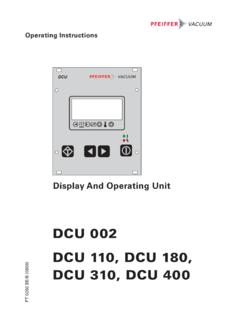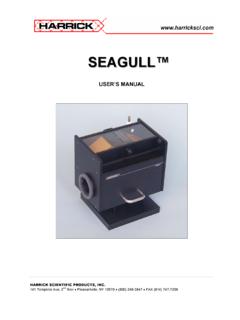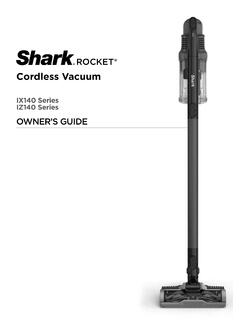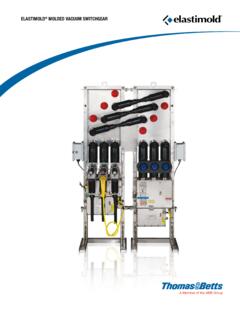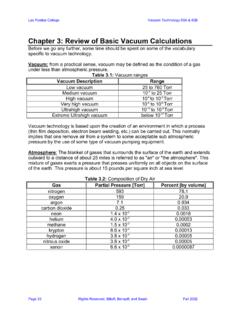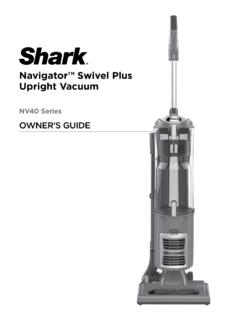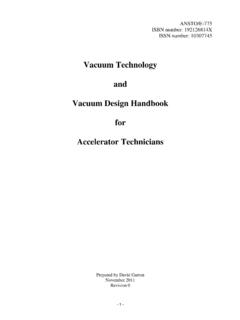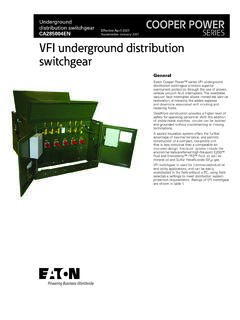Transcription of Working with Turbopumps
1 Working with Turbopumps Introduction to high and ultra high vacuum production Working with Turbopumps Foreword Empty space, meaning a volume not filled The content of this brochure is orientated with air or any other gas is referred to as to the most important questions that arise a vacuum . Ideal vacuum conditions exist concerning the generation of vacuum : in interstellar space. In interstellar space What terminology is used in vacuum there is a particle density of one atom technology and how is it defined? per cm3. In a laboratory or in industry, a (Chapter 1). vacuum is created using various vacuum pumps. Different requirements pertaining How does a turbopump function?
2 To the quality of the vacuum are placed on (Chapter 2). the vacuum depending on the application. What are the various types of turbo- For this reason, vacuum applications pumps and what are the differences? are divided into the following categories: (Chapter 2). rough, medium, high and ultra-high vacuum . What must I know in order to operate and to service a turbopump? One of the most important instruments for (Chapter 3). creating high vacuum is the turbomo- lecular pump (TMP), also referred to as a What accessories are required and in turbopump, that was developed and what circumstances? (Chapter 3). patented in 1957 by Dr.
3 Willi Becker at Which combination of turbopump and Pfeiffer vacuum . The turbopump quickly backing pump is necessary for my pro- became a success and now is more wide- cess? (Chapters 4 and 5). spread than the diffusion pump which was the most widely used type of pump Examples of applications (Chapter 6). up until that time. Its ease of operation, and the data lists (Chapter 7) provide its long life and the oil-free high vacuum it the answers to specific questions. creates are the reasons to this day for the We hope that you will find this brochure success of the turbomolecular pump. an interesting and useful guide in your Even today, 250,000 pumps later, Pfeiffer daily vacuum operations.
4 vacuum is the innovative world market leader for this pump. Working with Turbopumps covers the basic principles concerning the use of tur- bopumps for the generation of vacuum . Figure 1. The first turbopump developed and patented in 1957 by Dr. Willi Becker at Pfeiffer vacuum . 2. Index ..Page 1. Basic Principles and Definitions .. 4. Terms used in vacuum Technology .. 4. 2. Turbopump Overview .. 8. The Principle .. 8. Design and Operation .. 8. Classical Turbopumps .. 8. 9. CompactTurbo ..11. MagneticTurbo ..12. CorrosiveTurbo ..13. 3. Operating Turbopumps ..14. Electronic Drive Units ..14. TC 100, 600 and 750 for Conventional Turbopumps .
5 14. TCP 350 as a Separate Drive TCM 1601 for Magnetic Bearing Turbopumps ..15. Serial Interface ..16. Standby-Operations ..16. Rotation Speed Setting Mode ..16. Operating Modes for Various Gas Types ..16. Heating ..17. Venting ..17. Vibrations ..17. Frequency Analyses ..17. Anti-Vibration Magnetic Fields ..18. Turbopumps in Magnetic Fields ..18. Magnetic Fields of Safety ..19. Operational Safety of the Turbopump ..19. Safety for Operating Personnel ..19. 4. Applying and Dimensioning Turbopumps ..20. The most Important Parameters ..20. Applications without Process Gas ..21. Pumping Curves ..21. Pressure Range from 10-6 to10-8 mbar.
6 24. Pressure below 10-8 mbar ..25. Baking Out ..25. Residual Gas Applications with Process Gas ..26. Low Gas Loads < mbar High Gas Loads > mbar l/s ..26. 5. Intake And Outlet Line Losses ..28. Conductance Values for Molecular Flow ..28. Conductance Values for Laminar Flow ..30. 6. Application Examples ..32. 7. Data Lists ..34. 3. 1. Basic Principles and Definitions Terms used in vacuum Technology This chapter explains the most commonly Absorption used terms in vacuum technology and A Absorption is a sorption in which the gas illustrates the principles involved. In (absorbate) penetrates into the interior of particular, terms that are directly the solid body or liquid (absorbent).
7 Connected to the use of turbomolecular Adsorption pumps are explained. For detailed Adsorption is a sorption in which the gas calculations, please refer to the chapter (absorbate) is bound to the surface of a Applying and dimensioning turbo- solid body or liquid (absorbent). pumps and Intake and outlet line los- ses . Backing pump A backing pump is a vacuum pump that generates the necessary exhaust pressure for a high vacuum pump from whose pumped gas flow is expelled against atmospheric pressure. A backing pump can also be used as a rough vacuum pump. C Compression ratio The compression ratio is the ratio of the outlet pressure to the intake pressure of a pump for a certain gas.
8 D Desorption Desorption is the release of absorbed or adsorbed gases from a surface. The re- lease can be spontaneous or be accele- rated by physical processes. Exhaust pressure E The exhaust pressure (pVV), also known as the fore- vacuum pressure, is the pressure on the fore- vacuum side of the turbo- pump. A turbopump cannot expel against atmosphere and requires, therefore, a vacuum on the exhaust side (the fore- vacuum ) which, depending on type, must be between and 20 mbar. Diaphragm pumps, oil-sealed rotary vane pumps, Roots pumps or other dry backing pumps are used to generate the vacuum . Final pressure Figure 2.
9 F The final pressure is the value of the pres- TPD 011 The sure that is asymptomatically approached smallest turbo- in a blanked off vacuum pump under pump in the world. normal operation and without the admis- Developed at sion of gas. Pfeiffer vacuum . 4. another (Figure 3). Instead, one type of pend = (ppart, v v /Kmax) flow goes through a slow transition to another type of flow. The resulting phen- omena can be ascertained mathemati- Formula 1. cally, but the result is relatively complex Flange formulas, especially when dealing with There are 3 different standardized flanges the Knudsen flow; the transition phase used in high vacuum technology: from laminar to molecular flow.
10 The CF (ConFlat) flange connection is a Flow conductance value symmetrical connection with a CU seal. The flow conductance value (C) of an ori- It is used in ultra high vacuum technology fice, a pipe or a piece of a pipe between (p<10-8 mbar) because of its low leak and two defined cross-sections is defined in desorption rates as well as its bake-out Formula 4. It is assumed that the tempera- compatibility. The flanges are standard- ture is in equilibrium throughout the ized (PNEUROP 6606, ISO 3669). system. The ISO flange connection is a symmet- rical flange connection with elastomer Q. seal and supporting ring.


